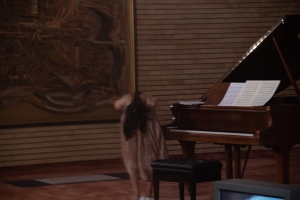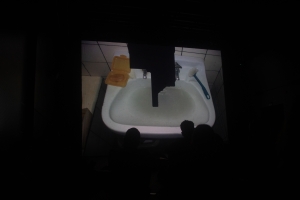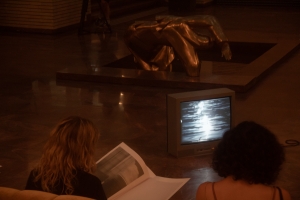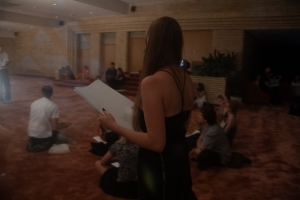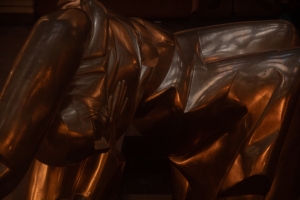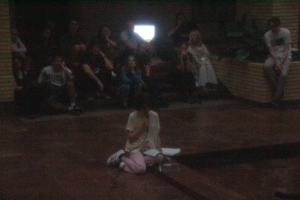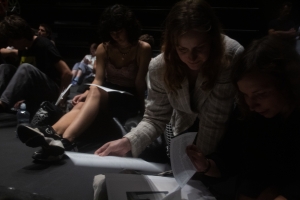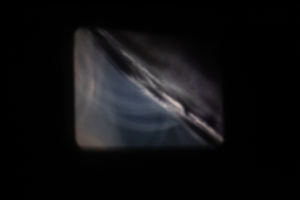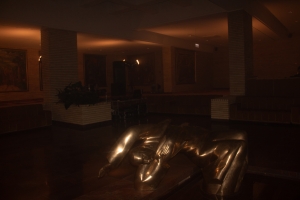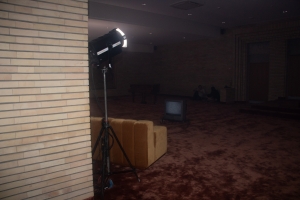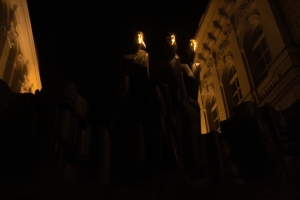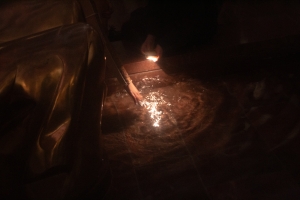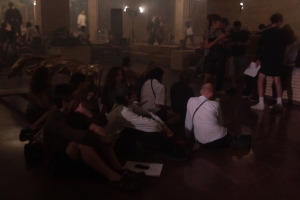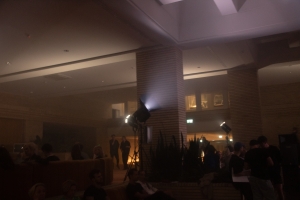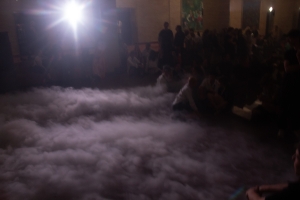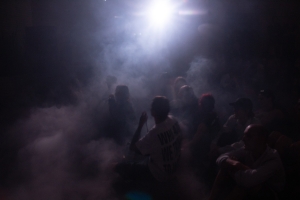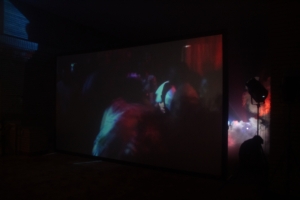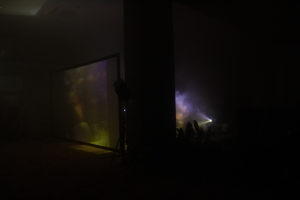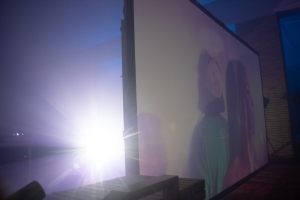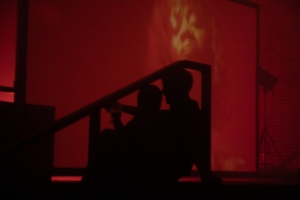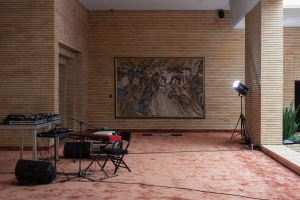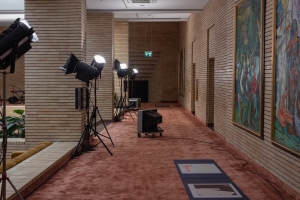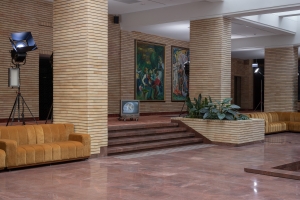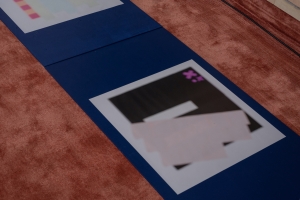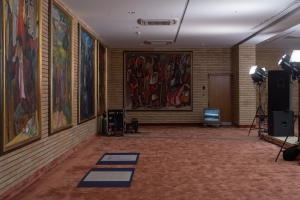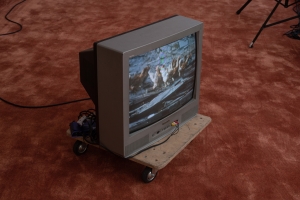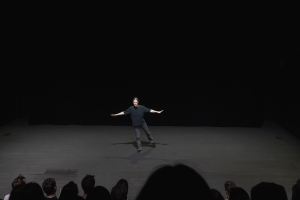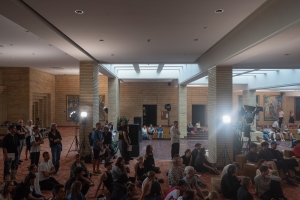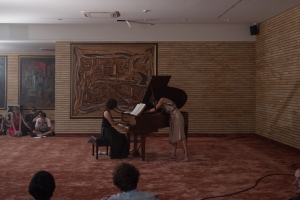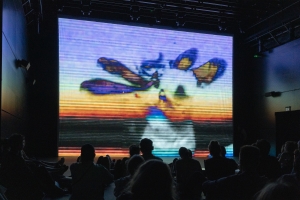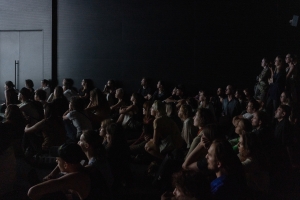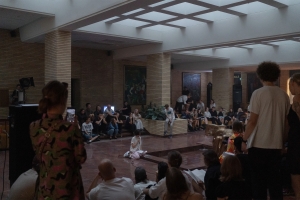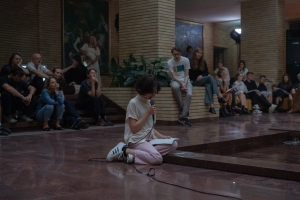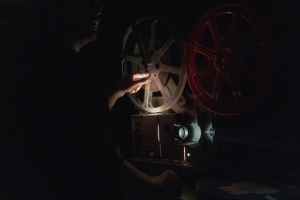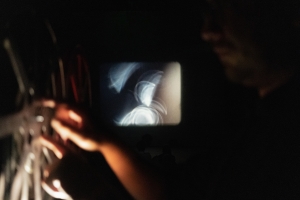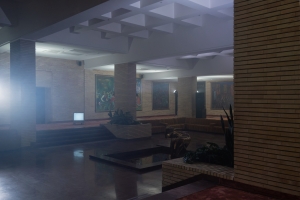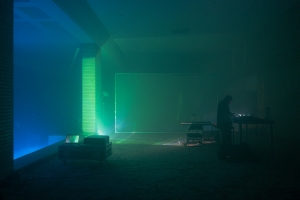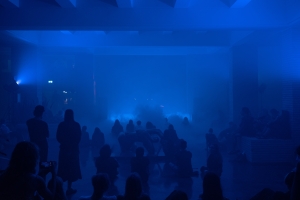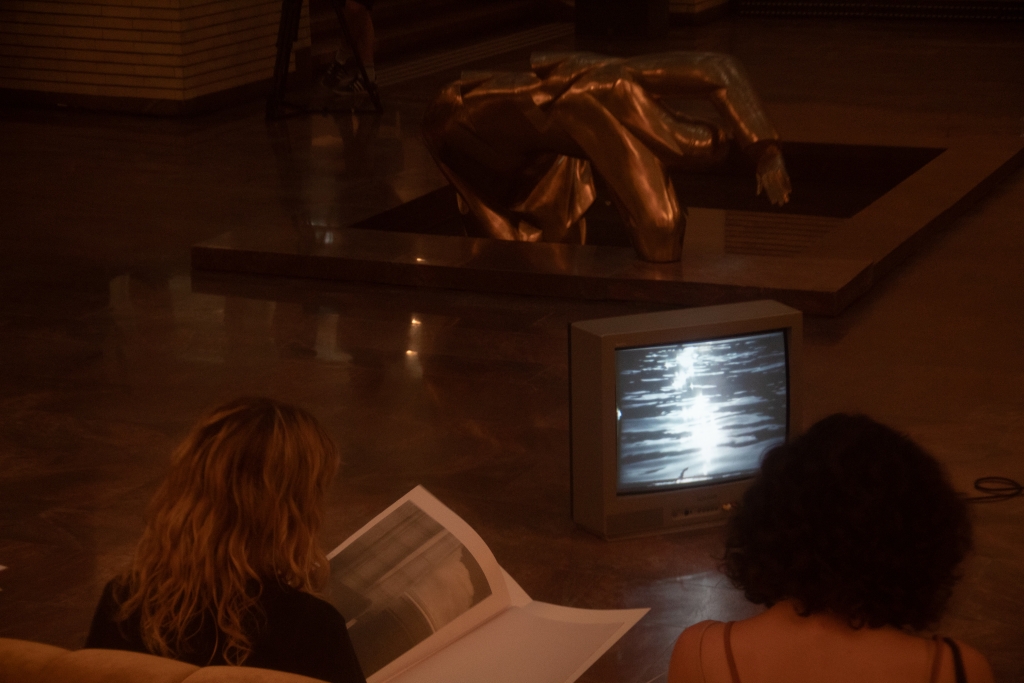
The 15th edition of the Baltic Triennial will open on 6 September 2024 and will run until early 2025. Curated by Tom Engels and Maya Tounta, it will be one of the first projects to open at the CAC’s main venue in the Old Town of Vilnius, which is currently still undergoing extensive renovation.
The introductory event of the Triennial – the prologue – took place in the summer of 2023 at the Lithuanian National Drama Theatre and shed light on the curators’ vision for the forthcoming main exhibition. This interview conducted by Virginija Januškevičiūtė returns to that event in an attempt to further unpack their ideas.
During the prologue the curators invited the audience to experience a gradually unfolding, carefully curated selection of films, prints, poetry, performance, music, and other artworks. The event also acknowledged the presence of artworks and the scene that preceded it: the famous sculpture from 1981 by Stanislovas Kuzma in the foyer, the paintings surrounding it from a similar period that were mostly created especially for this particular interior and belong to the theatre’s collection, as well as an artist-run music venue across the other side of the river. A folder containing a series of Remigijus Pačėsa’s photographs from around 1980 was published as a limited edition especially for the occasion, marking the curator’s aim to produce a tangible record for the future as well as to revisit the archives of the near past. Still, the main focus was on the experience of the immediate audience that shifted from hour to hour along with the choreography of the night.
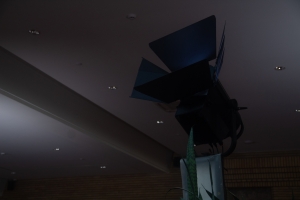
The prologue lasted just a few hours but it was highly complex – how would you summarise it?
Tom Engels: In crafting the prologue, we opted against a conventional curatorial brief that would elucidate what the Triennial would be about, choosing instead to delve into how the format of a prologue, similar to those found in literature or music, could set an engaging tone for the upcoming exhibition. This approach was more than a simple introduction; it was a deliberate act of tone-setting, of tuning, and of rehearsal. It was also an invitation to a one-off journey, emphasising the beauty of sustained engagement by creating a flow that encouraged continuous communal watching and listening. By arranging the artworks in choreographed sequences from the atrium to concentrated moments of shared attention in the theatre, and weaving back and forth between these spaces, we avoided creating an ‘aboutness’, yet could hint at the upcoming Triennial through the works, their intensities and their temporal arrangement. In a way, the atrium, a place where one resides before, after, or during the intermission of a play or concert, acted as a literal and metaphorical threshold: as a place before the theatre, as a place before the triennial, as a place where we would keep returning back to, to ‘remain in zero.’
‘Remain in Zero’ was also the title of the event, borrowed from a poem by Emerson, an unpublished author whose work was found in a private archive in Greece. What drew you to his writing?
Maya Tounta: With Emerson, it’s important to provide some context. I’d been working with the estate of a Greek photographer called George Tourkovasilis who I’d met a few years before and who passed away unexpectedly in 2021. Tourkovasilis was a known figure in the music community because in the 1980s he wrote a book about the rock and post-punk scene in Athens, but he was less known for his expansive photographic practice. Looking back at decades of photographic production, he had set aside a smaller selection of images that he felt were most indicative of his work and these were the only images that for a while could be viewed. When I later gained access to the archive, I discovered photographs, paintings, texts, and poems, which weren’t his but rather gifts from friends, and many of these were authored by people who hadn’t necessarily identified as photographers, painters, or writers during their lifetimes. People who made artwork at certain points or through their interaction with Tourkovasilis; in the case of Emerson even using Tourkovasilis’ camera, and having his photographs printed and developed by Tourkovasilis, as well. Among these photographs, there was a collection of poetry called ‘Songs Without Music’, lyrics to nascent songs in a manuscript. Emerson himself appeared in photos taken by Tourkovasilis throughout his life, at various ages, with different haircuts, and in different places. In the archive, and through their artefacts a portrait of a friendship appeared, and of its very private, intimate form of artmaking. ‘Remain in Zero’ was one of the ‘songs’ in that collection, and we decided to name the prologue after it, partly because it spoke to the collection at large and therefore to this rare and treasured context for artmaking, and partly because it encapsulated a movement from a to b which mirrored, in retrospect, the prologue itself, the progression of the works from the beginning of the day to its end. And in some ways, we wanted to commemorate that echo, rather than illustrate it.
More specifically, the poem speaks to this movement from experiencing something through the prism of its absence or of an absence associated with it, towards a feeling of being present together with something and standing still without echoes from the past or projections into the future. A box has nothing in it, a bone doesn’t have skin, a heart doesn’t have a visible body, a night doesn’t have a dream, a window has no view, a smile is without love, a life repeats. By the end of the poem, the box is just a box, a bone is a bone, a heart is a heart, and a night is only a night. This has happened through Emerson’s repeating wish: ‘May you found yourself in a zero’ [Emerson was not a native English speaker and used English grammar inconsistently]. At the bottom, there’s just a zero and we remain in it. Things have equalised.
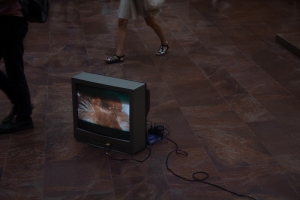
How did you put the programme together?
MT: Throughout the process of putting together the Triennial, Tom and I have often responded very similarly to artworks and circumstances, and so, this has allowed us to use this convergence almost as a guideline. We’ve been lucky to agree on so much.
TE: Integrating the archive was Maya’s way of engaging with the materials I had been proposing, which evolved into a collaborative method. We select materials to which we feel a strong personal connection, turning them into a foundation for our dialogue. By allowing these elements to bounce, we observe and steer their influence on each other – their interactions and the atmosphere they create become kinds of scores, milieus, moods, or patterns that led us to curating ‘Remain in Zero’ without wanting to duplicate or illustrate these original sources. Rather, the contributions were organised by a dramaturgy of moods and intensities, allowing one work to prepare the way for another, seeking a porosity between them.
I had brought the novella The Shadow of the Coachman’s Body (1952) by Peter Weiss to the table. This story describes the life of a writer confined in a boarding house, striving to mimetically depict and reproduce its atmosphere and, by extension, the broader world. Upon realising the disconnect between his writing, his art, and the world, he resorts to placing salt in his eyes to alter his perception and, consequently, his writing. This act of sustained observation – remaining engaged, repeatedly and almost obsessively examining our immediate environment to see it in a different light – was particularly intriguing to us. It is the reason many of the works in ‘Remain in Zero’ are built from everyday elements, yet are manipulated in such a way that they present themselves to us anew, allowing us to discover another form of life in them.
‘Remain in Zero’ also took a stand on the politics of production: the belief that we can achieve a great deal with minimal resources. Our interest lies in the everyday and in the processes through which artists create, challenging what is traditionally viewed as significant. This isn’t about romanticising scarcity but about reconsidering the means of production and evaluating the true necessities for creating depth and transformation. It underscores the value of utilising simple, everyday materials – things that are readily available, at hand, and woven into the fabric of daily life. Because the most simple things, when approached thoughtfully, hold immense value, capable of revealing the intricate worlds hidden within. I see it as a necessary act of humility and what I think art does best at the moment.
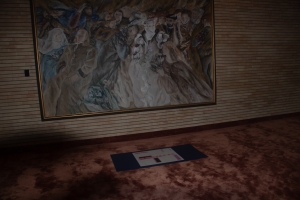
What does it mean for you to curate the Baltic Triennial in terms of context, and also responsibility?
MT: The Baltic Triennial has a distinctive history as an exhibition platform, and also as an epitome of the Contemporary Art Centre’s (CAC) legacy, which is both lonely in its singularity (as an art centre looking outwardly to other institutions) and deeply communal in how it has vitalised a certain community. Though structurally it has been eclectic, throughout its 14 iterations it has sustained a defiance to programmatic definitions of meaning, and at times resisted professionalisation, which feels rare. The ‘Mindaugas Triennial’ (the 11th edition, organised in 2012) presented the contributions of artists through ‘a radically minimised vessel: a single human being,’ a hired actor given a common Lithuanian name, in the more condensed format of a 12-day event. While, ‘BMW (Black Market Worlds)’ (the 9th edition, organised in 2005) preserved a cloistered life for its artworks, intimating wholes through barely visible crescents, hosting a second opening on an aeroplane mid-flight. In dialogue with one another, each Triennial has denied cohesion to its predecessors, each honouring joy or movement in its own way. As a whole, the Triennial has cast an atmosphere of disarray and out-of-jointness, seeking only fugitive clarity and thereby allowing curating and art-making to only ever be unknowable and so, inexhaustible. It’s expansive. In the current climate of exhibition valorisation, this perceived inaccessibility could be contested as apolitical, detached, or navel gazing. In my opinion, it contains a radicality generally missing from a lot of the art that proclaims itself political. Our commitment and responsibility to this legacy is to contemporise this polemic and to do so through work that champions empathy without necessarily narrating it.
TE: We seek resonance with that legacy of experimental exhibition-making, wherein exhibitions possess an almost immanent existence. I don’t see these merely as collections of works of art, but as compositions in their own right, with strong experiential dramaturgies, with a life of their own. They each were invariably and deeply influenced by the cultural, social, and political landscapes in which they are situated, absorbing and reflecting the zeitgeist of their era. Yet, intriguingly, they did not confine themselves to a straightforward, mimetic, or illustrative representation of reality. Instead, many of those propositions transcended conventional, striated modes of representation, challenging and expanding the boundaries of how art can interact with its audience, of how it can produce meaning in the widest sense. Today nearly everything is meticulously quantified according to an interest, be it socio-political or economic, and this functionalist perspective makes that the core of what makes something genuinely moving often risks being overlooked. Within this context, the spirit of experimental exhibition-making, which has flourished since the early nineties at the CAC, deserves not just recognition but a fervent defence. When viewed from a broader perspective, it becomes evident that this vibrant, exploratory approach to curating and exhibition creation, once burgeoning with potential, is now facing a decline in the face of contemporary demands for tangible outcomes and direct benefits.
The decreasing prevalence of such spaces today makes the protection of their existence not only necessary but almost celebratory as we need and will keep on needing them. It is a call to appreciate and preserve the intangible qualities that these experimental practices bring to the table – qualities that inspire, challenge, and provoke thought in ways that overcome the limitations of metrics. That’s one way of thinking about the alignment of context and responsibility.
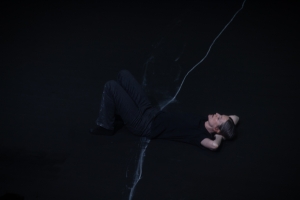
What helps you find your own grasp on it?
MT: Perhaps it’s the introspecting on our existing investments.Whether these are rooted in personal experiences, i.e. within the fringes: gatherings, parties, improvised rituals, or in more formulaic encounters through exhibitions, events and other generally organised experiences, which hopefully ring personal too. There are alignments that happen naturally, and eventually form a trajectory. A trajectory in the sense of lineage (a rootedness to the past) and a propensity (a projection for the future). When that trajectory coincides with trajectories felt in and by other people – in this case, this has happened a lot with Tom, and many of the artists we’re working with – or, contrarily, when it doesn’t, and you are separated – it’s important to stay true to the things that move you. Convergence allows for something communal to emerge. And through separation, there’s an opportunity to accept a limitation, and even take on the challenge of potentially seducing someone to your side.
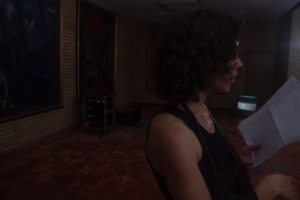
Was it important that both of you have a long-standing relationship with Vilnius?
MT: In different ways, we’ve both been informed by Lithuania over the years. I’ve lived there and Tom knows Lithuania through friends and other encounters. So, this is an opportunity for us to mirror back to the city the best of what it has given us, the best of what it has inspired in us. In some ways, we are creating a site-specific exhibition, or a site-specific address. However, that specificity isn’t necessarily only geographical.
TE: Recently, I realised that I spent a big chunk of time in the ‘negative space’ of the Baltics, and Vilnius specifically. For more than a decade, my life was interwoven with a diaspora of Lithuanian and Estonian artists, curators, and cultural workers who, having ventured abroad for education, chose to make their lives there. This connection has rendered me an inhabitant of a narrated Vilnius, living amidst its echoes in the memories and stories shared by these individuals.
Maya and I discovered, upon our meeting, that our paths had inadvertently crossed through our collaborations with similar, sometimes Lithuanian, artists. This serendipitous intersection underscored the complexity and subtlety of how such networks and connections form over time – some through deliberate effort, others as by-products of shared interests or others just because. This insight shapes our approach to work: we adopt an intuitive methodology that goes beyond simple personal preference. It recognises a powerful, though not always visible, influence within the creative process – a force that shapes our connections in ways that are not always easy to put into words. This is not out of a disdain for discourse or an aversion to discussion; rather, I’m deliberately looking for those elusive fissures where meaning defies transparency, description, justification or rational explanation, and that in itself produces a sensory discourse. That’s why we don’t reduce the curating of the Triennial to a set of valorised themes or limit it to a curatorial language that we know. Perhaps it’s precisely this subtlety that can foster a sense of possibility. This feeling comes from the accumulation of our experiences, the relationships we’ve built and the points where our artistic paths meet.
Language editor: Gemma Lloyd
Cover image: Margaret Raspé, films, 1971–1979, Remigijus Pačėsa: Fragmentas, edited by Maya Tounta and Tom Engels, designed by Julie Peeters, publication, 2023. Photographer – Saulė Gerikaitė
